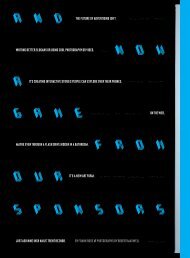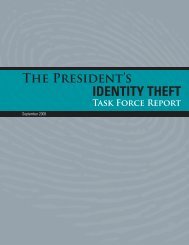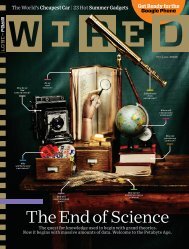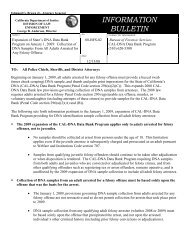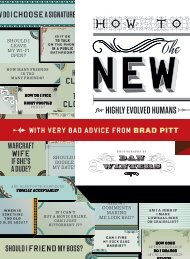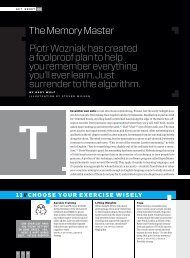Download PDF - Wired
Download PDF - Wired
Download PDF - Wired
Create successful ePaper yourself
Turn your PDF publications into a flip-book with our unique Google optimized e-Paper software.
Stuck on the<br />
tarmac Air travel<br />
sucks. Awake<br />
at 3 am Car alarms<br />
suck. Cell phone<br />
dead Batteries suck.<br />
Nothing works<br />
the way it should.<br />
With help from<br />
comedian Sarah<br />
Silverman, we looked<br />
into this world<br />
of lousy products and<br />
failed technologies.<br />
We didn’t find<br />
solutions to all these<br />
problems—but<br />
we did find some<br />
explanations.
photographs by art streiber<br />
hair and makeup: adrienne herbert/celestine agency; wardrobe: blair levin/timothy priano; prop stylist: matt luem<br />
let’s be clear: Sarah Silverman does not suck.<br />
Quite the contrary: From her early work on The<br />
Larry Sanders Show to her current TV series on<br />
Comedy Central, she is eye- meltingly funny. Her<br />
shtick demonstrates that she’s a keen observer of<br />
all that sucks around us. On The Sarah Silverman<br />
Program, she plays a character (conveniently<br />
named “Sarah Silverman”) who’s abrasive, insensitive, even a bit<br />
dumb. And in her stand-up act, she delights in flouting social<br />
taboos—scatology, racism, misogyny. (Her most quoted joke: “I was<br />
raped by a doctor. Which is so bittersweet for a Jewish girl.”) Silverman’s<br />
arch perspective on the world makes her the perfect pitch<br />
person for our explanations of why things don’t work the way they<br />
should. Yet out of character, Silver man rejects cynicism. “A lot of<br />
comics have a kind of superstition,” she told us. “They romanticize<br />
misery and think they need it to be funny. I don’t thrive on that at<br />
all.” No misery Does she not know how much things suck She<br />
doesn’t buy it. “I love technology. I’m all for it,” Silverman says. “I<br />
watch my common-law stepdaughter iChatting with her boyfriend<br />
every night, and it’s the fucking future happening now. It’s amazing.”<br />
Push her and she goes zen: “I would say the only things that truly<br />
suck are those things you cannot control,” she says. “All other sucky<br />
shit can get unsucked just by changing your perspective a degree or<br />
two, or just doing something about it.” That kind of sunny optimism<br />
has no place in this issue. Luckily, she does have her moments<br />
of outrage. Like when idiots in her audience shoot low-quality video<br />
of her stand-up act and post it to YouTube. “I make a joke explaining<br />
why I’m asking them to stop, and then guess what,” she says.<br />
“They keep shooting—usually with shit-eating grins on their faces,<br />
waiting for me to get mad or do something embarrassing. Those<br />
people suck. They suck balls.” Ah. There’s the Sarah we love.<br />
What’s inside:<br />
Air travel<br />
Batteries<br />
Booze<br />
Car alarms<br />
Credit cards<br />
Customer service<br />
DVD sound<br />
Evite<br />
Fuel economy<br />
Hearing aids<br />
Infertility treatments<br />
Junk mail<br />
Knees and backs<br />
Medical records<br />
Office copiers<br />
Plastic packaging<br />
Prescription drugs<br />
Printer ink cartridges<br />
Radio<br />
Roads<br />
Robots<br />
Science<br />
Spam filters<br />
Subscription cards<br />
Teleconferencing<br />
Ticket purchasing<br />
Tomatoes<br />
Traffic<br />
Vending machines<br />
Web video<br />
Whiteboards<br />
Wireless speakers<br />
Things that don’t suck<br />
i l l u s t r a t i o n s b y m a r t i n w o o d t l i<br />
+<br />
0 1<br />
1
0 2<br />
1<br />
Evite is great if you’re<br />
gonna party like it’s<br />
1999—because that’s where<br />
the site has been stuck for<br />
nearly a decade. An email<br />
arrives announcing a fete,<br />
but it’s short on deets.<br />
You’re forced to click to an<br />
ad-choked Web page,<br />
then another to RSVP, and<br />
then back to the first to see<br />
the info again. That faint<br />
sound you hear It’s coins<br />
tumbling into the pockets<br />
of media conglomerate<br />
IAC/InterActiveCorp, which<br />
acquired the site in 2003.<br />
And that, of course, is<br />
the point—all that clicking<br />
means dollars for them. •<br />
So why are 16 million of us<br />
registered Evite users<br />
There simply hasn’t been a<br />
good alternative that, like<br />
Evite, was free and didn’t<br />
require RSVPers to<br />
register—until recently. To<br />
announce your next highstakes<br />
Scrabble tourney,<br />
try Socializr, brought to<br />
you by Friendster founder<br />
Jonathan Abrams. It’s Evite<br />
2.0, finally. —Kimberly Hiss<br />
1<br />
8<br />
9<br />
2<br />
2<br />
medical records<br />
They’re a mess!<br />
most medical records are about as orderly as an ER on Saturday<br />
night. Because they’re mainly confined to paper, they can’t be<br />
easily transferred from one physician or hospital to another. And<br />
because they’re not subject to any standards (or even legibility<br />
requirements), they’re nearly impossible to compare and combine.<br />
Improving the system is possible, but it would take the<br />
cooperation of a bunch of interest groups that have no interest in<br />
working together. The Health Insurance Portability and Accountability<br />
Act, passed by the federal government in 1996, was supposed<br />
to fix things, but massive lobbying turned it into porridge.<br />
For example, HIPAA lets states make their own rules; now some<br />
states say doctors should keep records for 20 years, some for two.<br />
You’d think electronic records would solve the problem, but no.<br />
Because the software vendors selling electronic record- keeping<br />
systems are competing,<br />
their systems<br />
are proprietary and<br />
incompatible. Oddly,<br />
that’s OK with many<br />
physicians. Another<br />
name for an all-knowing, all-seeing, all-compatible electronic<br />
system is database, and physicians don’t want people mining<br />
theirs—not because of patient-privacy concerns, but because<br />
the info could be used for doctor-on-doctor performance stats.<br />
Plus, docs already hate filling out charts; you think they want to<br />
learn data entry A fix may be on the way. Google and Microsoft<br />
are both working on software that will appeal to physicians<br />
and patients alike. (Kind of gives new meaning to “blue screen of<br />
death,” don’t it) But a word of advice: Pressure your docs into<br />
accepting a more transparent system. If you don’t understand<br />
your chart, ask. You want some surgeon to cut the wrong leg off<br />
of you someday —erin biba<br />
Wireless Speakers: Don’t bother.<br />
We all love the idea<br />
of wireless speakers<br />
—just plug the<br />
system’s base into<br />
your stereo and put<br />
the speakers wherever<br />
you want. The<br />
reality Bad sound<br />
and interference—<br />
loads of interference.<br />
Doctors hate filling<br />
out charts; you think they<br />
want to learn data entry<br />
The big problem is<br />
multiple conversions:<br />
To prevent hi-res<br />
bootlegging, the digital<br />
signal—Dolby<br />
Digital, DTS, whatever—from<br />
your CD<br />
or DVD is converted<br />
to analog when it’s<br />
output to a multichannel<br />
receiver.<br />
Then, to reach your<br />
wireless speakers,<br />
this signal must<br />
either be reconverted<br />
to digital format (further<br />
degrading the<br />
sound) and sent wirelessly,<br />
or turned into<br />
a lower-quality analog<br />
signal sent by FM<br />
transmission. Either<br />
way, pristine audio<br />
isn’t an option.<br />
(Think how much better<br />
“Bohemian Rhapsody”<br />
sounds on your<br />
car CD player than<br />
over the local Clear<br />
Channel station.)<br />
Once the transmission<br />
reaches the wireless<br />
speaker, it must<br />
be reconverted so<br />
your analog speaker<br />
cones can rock the<br />
room. That’s at least<br />
three conversions—<br />
from digital to analog<br />
and back again—and<br />
each trip degrades<br />
sound quality. It’s just<br />
not worth it: You’ll<br />
need to run power<br />
cables to your speakers<br />
anyway, because<br />
no battery will crank<br />
out audio-level wattage<br />
for very long. It’s<br />
your choice: aesthetically<br />
offensive speaker<br />
cables or crappysounding<br />
Sigur Rós.<br />
—paul boutin
shouldn’t evolution have taken<br />
care of our blown-out knees and aching<br />
backs Instead, evolution may be<br />
to blame; chimps don’t tear menisci or<br />
herni ate discs like we do. It could be<br />
that our knees and backs are such a pain<br />
because we insist on standing upright.<br />
When our ancestors stood up on two<br />
feet, they stumbled upon a much more<br />
efficient way of walking that uses 75 percent<br />
less energy than knuckle-dragging.<br />
Over the next several million years, natural<br />
selection refined the structural modifications<br />
that keep our torso centered<br />
over our lower half as we put one foot in<br />
front of the other: longer legs, knobby<br />
knees, an elongated spine. But those<br />
adaptations can be a bit of a kludge.<br />
By stacking the thigh bone directly on<br />
top of the shin bone, we’ve saddled our<br />
knees with more weight than they can<br />
handle. Even when you’re just strolling<br />
down the street, the pressure exerted<br />
on your knees is three to five times your<br />
body weight. During more strenuous<br />
activity like running or climbing stairs,<br />
it can be double that. By the time you hit<br />
The number of cars on the road isn’t the problem.<br />
It’s all those idiots braking when they don’t have to.<br />
30, the cartilage that distributes your<br />
weight across the joint has already<br />
begun to wear away. The tissue loss may<br />
eventually lead to osteoarthritis, and the<br />
shin and thigh bones will begin to rub<br />
against each other. This so-called wearand-tear<br />
arthritis sends about 5.5 million<br />
people to doctors every year.<br />
The same thing happens to our vertebrae,<br />
which weren’t designed to sit<br />
on top of each other in one weightbearing<br />
column. With time, the cushions<br />
between the bones lose some of<br />
their spring, and then one day, as you lift<br />
a grocery bag or slump in your chair, a<br />
disc can bulge out of place. Pain, numbness,<br />
and spasms result because the disc<br />
is now pressing on a nerve that connects<br />
your spinal cord to the rest of your body.<br />
More than 80 percent of working Americans<br />
will suffer from back pain that’s<br />
severe enough to limit their activity at<br />
some point during their careers.<br />
Surgery is just a temporary fix for<br />
our anatomical woes. After a decade,<br />
replacement cartilage can wear away,<br />
too. But we can’t blame all of our aches<br />
on design flaws. The fact<br />
that we spend so much time<br />
hunched over a keyboard—<br />
level 70 World of Warcraft<br />
players, are you listening—<br />
can’t be good. It might help<br />
if we all got up off our highly<br />
evolved duffs more often.<br />
—greta lorge<br />
Our nation is gridlocked. Congested roadways mean that each year, the typical US commuter spends about<br />
40 hours in traffic. That adds up to $78 billion in lost time and wasted fuel, not to mention environmental<br />
damage, road rage, and the proliferation of lame drive-time shock jocks. What’s worse, most jams aren’t the<br />
result of an accident or a breakdown; they have no clear cause at all. Drivers react to other drivers, and those<br />
drivers react in response. A tiny hiccup in traffic—you’re fiddling with the radio and get a little too close to the<br />
car in front, so you hit the brakes—can send a tremor rippling upstream for<br />
miles. One Japanese scientist found that in moderate traffic, a single erratic<br />
vehicle can trigger feedback effects that push the entire system into a new<br />
equilibrium: a standstill. • The reflexive response to congestion is to add<br />
more road capacity. But that, alas, is self-defeating. As the history of cities<br />
like New York and Los Angeles shows, a new bridge or expanded artery just<br />
invites more people to drive. In the long run, it alters decisions about where to<br />
live and work—highways create suburbs, not the other way around. Pent-up<br />
demand around major US cities is so great, urban planners say, no amount<br />
of construction would alleviate gridlock. Singapore, London, and Stockholm<br />
have tackled rush hour problems with “congestion pricing” schemes that<br />
use heavy fees to encourage people to share rides or limit downtown trips<br />
to off-peak hours. Can the US hop on the same bus A similar proposal for<br />
New York City has stalled. —Lucas Graves
Long lines. Frequent delays. Disrobing for security while your flight completes final<br />
boarding. Here’s why your plane trip is ridden with misery. —Mathew Honan<br />
Ticket Counter<br />
Expensive If anything,<br />
flying doesn’t<br />
cost enough: The<br />
average domestic<br />
fare in spring 2007<br />
was $326. That’s $50<br />
less than a decade<br />
ago, after adjusting<br />
for inflation. During<br />
the same period, fuel<br />
costs nearly tripled.<br />
To stay in business,<br />
major carriers have<br />
aped the strategies of<br />
budget operators like<br />
Southwest. Largely<br />
gone are the free<br />
meals, blankets, and<br />
pillows. The savings<br />
have been passed<br />
along as lower ticket<br />
prices—at the price<br />
of your comfort.<br />
Security Line<br />
September 11<br />
changed flying forever,<br />
and would-be<br />
shoe bomber Richard<br />
Reid changed it<br />
again. The so-called<br />
liquid terror plot in<br />
the UK made it a trifecta.<br />
As a result, the<br />
list of prohibited and<br />
permitted items is<br />
mystifying. Gel shoe<br />
inserts, snow globes,<br />
or a 6-ounce bottle<br />
of spray deodorant<br />
No way. Corkscrews,<br />
cigarette lighters, and<br />
6.5-inch screwdrivers<br />
No problem. Meanwhile,<br />
security delays<br />
vary drastically from<br />
airport to airport. The<br />
average wait time in<br />
Los Angeles on Monday<br />
at 8 am is just<br />
four to 11 minutes; at<br />
Atlanta’s main checkpoint,<br />
it’s up to 26.<br />
Tarmac<br />
A storm in a hub city like Chicago can quickly bog<br />
down the entire system. As a result, more than<br />
a quarter of US flights were stuck on the tarmac<br />
last year. In the peak summer season, that number<br />
reached almost 30 percent. A tip: If you book online<br />
(and who doesn’t), you may be able to select your<br />
flight based on its on-time performance. United’s<br />
Web site, for example, displays statistics for each<br />
flight when you make reservations. The industry<br />
on-time average is 73.5 percent.<br />
Average security<br />
wait at LAX: 4 to 11<br />
minutes. In Atlanta:<br />
nearly half an hour.<br />
Baggage<br />
As many as 80 million<br />
bags are checked<br />
every month, yet<br />
only 7.25 out of every<br />
1,000 travelers complain<br />
of mishandled<br />
luggage—not bad. But<br />
in 2006 it was 6.45,<br />
and 10 years ago it<br />
was 4.88. If they’re<br />
not reunited with<br />
their owners, many<br />
lost bags are sent to<br />
the Unclaimed Baggage<br />
Center in Scottsboro,<br />
Alabama, where<br />
their contents are<br />
sold to the public.<br />
Gate<br />
Airlines fill planes<br />
by overbooking and<br />
hoping some people<br />
don’t show up. But<br />
more than half a<br />
million passengers<br />
were bumped from<br />
flights in the first<br />
nine months of 2007.<br />
While many opted<br />
out for free roundtrips<br />
or other perks,<br />
52,000 were “denied<br />
boarding” involuntarily.<br />
That may not<br />
seem like a lot, but it’s<br />
up nearly 20 percent<br />
from a decade ago.<br />
Control Tower<br />
US airports are<br />
swamped. Last year,<br />
some 64 million takeoffs<br />
and landings<br />
were managed by a<br />
mere 14,874 air traffic<br />
controllers, a quarter<br />
of whom were<br />
new hires or trainees.<br />
Many of those cannot<br />
work alone. And<br />
despite the new<br />
blood, much of the<br />
current workforce<br />
is expected to retire<br />
within a decade.<br />
At the nation’s unclaimed<br />
baggage depot in Alabama,<br />
the contents of wayward<br />
suitcases are sold to the public.<br />
non-commissioned credits tk here<br />
illustration by Firstnametk Lastname
1 0 5<br />
More<br />
than a<br />
quarter<br />
of US<br />
flights<br />
were<br />
delayed<br />
last<br />
year.<br />
Airplane Cabin<br />
Nearly 800 million<br />
passengers flew on<br />
US airlines in 2007,<br />
up 31 percent from<br />
2003. But while airports<br />
have never<br />
been busier, there are<br />
actually fewer planes<br />
in operation; in 2006,<br />
US carriers operated<br />
13 percent fewer aircraft<br />
than in 2000. So<br />
how do they accommodate<br />
everyone<br />
Welcome to the sardine<br />
can. Airlines<br />
have boosted cabin<br />
capacity by slashing<br />
legroom—the average<br />
coach seat today<br />
provides less than<br />
32 inches, down from<br />
35 in years past. On<br />
top of that, planes are<br />
flying fuller: Historically,<br />
65 to 70 percent<br />
of seats were filled;<br />
today it’s nearly<br />
80 percent. Don’t<br />
expect things to<br />
improve any time<br />
soon: The FAA forecasts<br />
that we’ll have<br />
1 billion passengers<br />
in the air by 2015.<br />
Radar<br />
The 50-year-old<br />
radar-based flighttracking<br />
system is<br />
responsible for many<br />
of today’s problems<br />
because it limits how<br />
closely planes can<br />
fly to one another.<br />
A new GPS-based<br />
system called Next-<br />
Gen will broadcast<br />
precise positions<br />
between aircraft for<br />
the first time, giving<br />
pilots more control<br />
over flight tracking<br />
and letting many<br />
more flights share<br />
the same airspace<br />
safely. It’s scheduled<br />
to come online by<br />
2025 and cost as<br />
much as $22 billion. In<br />
Alaska, where a similar<br />
system is already<br />
in place for small<br />
planes, the accident<br />
rate has dropped<br />
by 40 percent.<br />
s p a m<br />
filters<br />
as any grizzled football coach will<br />
tell you, good defense beats a good<br />
offense. But that wisdom doesn’t apply<br />
to the realm of spam, where porn peddlers<br />
and Nigerian hucksters regularly<br />
outwit the latest filtering software.<br />
The most obvious problem is that<br />
it’s simply not possible to update filtering<br />
software frequently enough to<br />
catch all of the spammers’ multifarious<br />
innovations—disguising unsolicited<br />
messages by replacing the “i” in<br />
Viagra with a “1” or using images in lieu<br />
of text, for example. At the same time,<br />
an overly aggressive approach can be<br />
disastrous, trapping legitimate email<br />
as false positives. One possible route<br />
to improvement: Instead of focusing on<br />
suspicious content, consider the trustworthiness<br />
of the sources. Oscar Boykin,<br />
a computer engineering professor at the<br />
University of Florida, suggests that filters<br />
would work better with more widespread<br />
use of authentication systems,<br />
which make it harder for spammers<br />
to forge source addresses. Emerging<br />
standards like Sender ID and Domain-<br />
Keys, for instance, verify that a message’s<br />
sender and domain are legit.<br />
Improved computer security would also<br />
help, since many illicit messages are sent<br />
from computers infected with malware.<br />
Yes, you can blame the porous Windows<br />
operating system for yet another of life’s<br />
agonies—the constant flood of emails<br />
slugged “dietpill Spurt!# xqrrasdqfh.”<br />
—brendan i. koerner<br />
non-commissioned credits tk here<br />
Whiteboards seem like genius—easy-to-read, no-dust versions of classroom chalkboards.<br />
Except Whiteboards …they never seem really, like really magic—easy-to-read, erase. The only thing no-dust that versions separates of classroom a dry-erase chalkboards.<br />
marker from<br />
Whiteboards a permanent Except that marker seem they like never is a genius—easy-to-read, touch really of erase. silicone The polymer. only no-dust thing It makes separating versions the of ink a classroom dry-erase in the dry-erase marker chalkboards. slippery from a<br />
Except permanent enough …they to marker wipe never off is really, the a touch porcelain really of silicone erase. or white The polymer, melamine only thing which coating that makes separates on the the ink board. a slippery dry-erase Unfortunately, enough marker to from wipe to be<br />
a permanent light off the enough board’s marker to porcelain mount, is a touch those or of white silicone whiteboards melamine polymer. are surface. pretty It makes Unfortunately, thin. the Which ink in means the to dry-erase be the light coating enough slippery wears to<br />
mount, enough out—every those to wipe whiteboards time off you the write porcelain are on pretty one, or white the thin. surface melamine The coating degrades, coating wears forming on out—every the board. microscopic time Unfortunately, you craters write that on to one, grab be<br />
the ink light surface more enough tightly degrades, to than mount, any forming those polymer microscopic whiteboards could hope craters are to pretty avoid. that thin. Eventually, hold Which onto ink, means the forming whole the thing coating a gray develops residue. wears a<br />
out—every gray That residue. brainstorm time That you session write brainstorm you one, left session the up surface for you three left degrades, months up there forming Unless three microscopic you months break out It craters moves the solvents, that into grab those it<br />
ink will more haunt tightly a cheap than board any polymer forever—a could permanent hope to avoid. ghost. Eventually, Hope they were the whole good thing ideas. develops —Erin Biba a<br />
gray residue. That brainstorm session you left up there for three months It moves into those<br />
illustration by Firstnametk Lastname
Car alarms are part of the sonic<br />
wallpaper of any city. We’re so<br />
used to cars crying wolf that<br />
no one takes the sirens and<br />
flashing lights seriously—when<br />
was the last time you thought a<br />
hysterical car was really being<br />
stolen The trouble with alarms<br />
is that they’re too dumb to see<br />
whether someone’s actually<br />
slim-jimming the door. Instead,<br />
the typical system relies on<br />
vibration or proximity sensors,<br />
which means it’s just as likely to<br />
be triggered by a passing truck.<br />
The result: endless false<br />
positives. Of course, good car<br />
thieves know how to thwart<br />
every system with nary a peep<br />
anyway. Your best defense<br />
Something covert like LoJack or<br />
OnStar that uses wireless<br />
transmitters to guide the cops to<br />
your boosted ride. —Joe Brown<br />
teleconferencing<br />
say what<br />
If you want to quash the hopes and<br />
dreams of any group of competent,<br />
intelligent people, put them on the<br />
phone together at the same time.<br />
For added fun, put them around<br />
one of those starfish conference<br />
phones. The first problem is simple<br />
social dynamics: The rhythm of a<br />
person-to-person volley vanishes<br />
in larger groups. In person, speakers<br />
tend to direct their eyes to<br />
whomever they expect to pipe up<br />
next. But on the phone, no one can<br />
predict when it’s their turn, and<br />
people cut each other off or pause<br />
too long. Now that’s a meeting! •<br />
The technology’s to blame, too.<br />
Notice how your regular telephone<br />
separates the microphone and the<br />
speaker That’s so the sound coming<br />
out of the earpiece doesn’t get<br />
picked up by the mouthpiece and<br />
echo back and forth in an infinite<br />
feedback loop. Your head is the<br />
buffer. But on a conference phone,<br />
the voices coming out of the<br />
speaker get picked up by the microphones,<br />
playing over and over (and<br />
batteries<br />
Power For your<br />
rolls royce laptop<br />
240 MIN<br />
70 min<br />
20 min<br />
this sad routine rarely varies: You spend a small<br />
fortune on a laptop that touts its extended battery life, and<br />
six months later you’re running out of juice after an hour.<br />
Why is it that computermakers can squeeze 250 gigs of data<br />
storage into a 13-inch notebook, but they can’t provide batteries<br />
that outlast your PowerPoint presentation Actually,<br />
battery manufacturers have made great strides over the<br />
past decade: A contemporary lithium-ion battery delivers<br />
double the juice of its early-’90s predecessors. But the power<br />
demands of laptops—and cell phones and digital audio<br />
players, for that matter—have soared as well. So instead<br />
of longer battery life, you’ve got a 2-GHz screamer that can<br />
burn DVDs, download songs, and search your hard disk all<br />
at the same time. Things would improve if electronics<br />
designers and batterymakers worked harder to match<br />
power supplies with the demands of specific processors.<br />
But Moore’s law doesn’t leave much time for collaboration:<br />
Consumers expect their next laptop to run twice as fast as<br />
their old one, so manufacturers focus on just getting the latest<br />
CPUs into their machines. Batteries are an afterthought,<br />
purchased from the lowest bidder<br />
louder and louder). To beat this and rushed through the qualityassurance<br />
process, which means<br />
problem, these phones typically<br />
turn off the voice channel when no<br />
one’s talking. But, like you, they short run-times and the occasional<br />
can’t guess when someone will laptop bonfire. Eventually, the<br />
start to speak, so there can be a lag hydrogen fuel cell may evolve into<br />
in reopening the channel. The better—and<br />
more expensive—solution a power source for portable electronics,<br />
but lithium-ion’s reign is due<br />
is echo- cancellation, which records<br />
every statement and deletes repetitions.<br />
But that’s a tricky task—<br />
to last another decade. What to do<br />
the software tends to clip voices in the interim Buy a second battery<br />
it mistakes for echoes. • Maybe pack. —brendan i. koerner<br />
you should just email. —Erin Biba
Credit Cards: Racking up the pain.<br />
Americans have a love-hate relationship with credit cards—and no wonder. Plastic is incredibly<br />
convenient. But there’s a dark side. A typical credit contract is structured to lead you ever deeper<br />
into debt. Result: 61 percent of US households pay interest on an average revolving balance<br />
of nearly $10,000. Here’s how a new card can turn into a financial nightmare. —Mathew Honan<br />
Applying<br />
Congratulations!<br />
You’ve been offered<br />
a line of credit. And<br />
not for the first<br />
time: Banks and<br />
other lenders sent<br />
out 5.3 billion solicitations<br />
last year,<br />
even though the<br />
average American<br />
family already holds<br />
three cards. But<br />
that introductory<br />
rate sounds so low,<br />
why not sign up for<br />
a new card<br />
spending<br />
Your credit card<br />
sure is handy: Plastic<br />
accounts for<br />
more than half of<br />
all point-of-sale<br />
transactions in the<br />
US. That on-thego<br />
spending has<br />
led US citizens to<br />
take on $850 billion<br />
in credit card<br />
debt—a $400 billion<br />
increase in the<br />
past decade and<br />
a major drag on the<br />
nation’s economy.<br />
borrowing<br />
Grabbing a little<br />
cash from the ATM<br />
is almost as good<br />
as finding a pot of<br />
gold. But beware.<br />
The average interest<br />
rate on cash<br />
advances is 20 percent,<br />
plus $5 to $10<br />
per advance. And<br />
since cash limits<br />
are typically lower<br />
than credit limits,<br />
it’s easy to accidentally<br />
trigger overlimit<br />
fees.<br />
maxing out<br />
Oops! You’ve<br />
reached your limit.<br />
No worries, banks<br />
love to increase<br />
your credit line.<br />
You should plan<br />
on paying more<br />
than the monthly<br />
minimum, though:<br />
At that rate, paying<br />
off a $6,000<br />
balance at 14 percent<br />
interest would<br />
take 31 long years<br />
—and cost you an<br />
extra $8,000.<br />
Paying the bill<br />
Think you’ve still<br />
got that low interest<br />
rate you signed<br />
up for Even if<br />
you pay in full each<br />
month, a bank can<br />
hike your rate for<br />
any change in your<br />
credit score or even<br />
for missing a payment<br />
on another,<br />
unrelated account.<br />
And if you carry<br />
a balance, the new<br />
rate applies retroactively<br />
to all of it.<br />
science<br />
morality, spirituality, the meaning of life—science doesn’t handle<br />
those issues well at all. But that’s cool. We have art and religion for that<br />
stuff. Science also assumes predictable cause and effect in a world that’s a<br />
chaotic, bubbling stew of randomness. But that’s OK, too. Our approximations<br />
are usually good enough. No, the real reason science sucks is that it<br />
makes us look bad. It makes us bit players in the Big Story of the universe,<br />
and it exposes some key limitations of the human brain. Look at it this<br />
way: Before science, we humans had dominion over Earth, the center of<br />
the universe. Now we’re just a bunch of hairless apes on a wet rock orbiting<br />
a minor star in a marginal galaxy. Even worse, those same cortexes that<br />
invented science can’t really embrace it. Science describes the world with<br />
numbers (ratio of circumference to diameter: pi) and abstractions (particles!<br />
waves! particles!). But our intractable brains evolved on a diet of campfire<br />
tales. Fantastical explanations (angry gods hurling lightning bolts) and rare<br />
events with dramatic outcomes (saber-toothed tiger attacks) make more of<br />
an impact on us than statistical norms. Evolution gave us brains that crave<br />
certainty, with irrational fears of crashing in an airplane and a built-in weakness<br />
for just-so stories about intelligent design. Meanwhile, the true wonders<br />
revealed by the scientific method—species that change into new species<br />
over time, continents that float around the planet, a quantum-mechanical<br />
world where nothing is for sure—are worse than counterintuitive. To a<br />
depressingly large number of us, they’re downright threatening. In other<br />
words, thanks to evolution, half of all Americans don’t believe in evolution.<br />
That’s the universe for you: impersonal, uncaring, and ironic. —Thomas Hayden<br />
The real reason science sucks is<br />
that it makes us look bad. It exposes some<br />
key limitations of the human brain.<br />
0 7<br />
1<br />
The tomato: Pink,<br />
mealy, and tasting like<br />
a whole lot o’ nothing,<br />
this sure isn’t the juicy<br />
scarlet orb you picked<br />
from your mother’s<br />
garden as a kid. That’s<br />
because a typical<br />
supermarket tomato<br />
is engineered to be<br />
durable, not delicious.<br />
Today’s farmers grow<br />
varieties that can be<br />
shipped and stored<br />
easily. After being<br />
harvested, the fruit<br />
spends weeks ripening<br />
in a warehouse (with<br />
the help of ethylene<br />
gas) and traveling<br />
long distances before<br />
reaching the shelf.<br />
How to avoid disappointment<br />
First,<br />
smell it: If it doesn’t<br />
smell good, it won’t<br />
taste good. Second,<br />
choose vine-ripened<br />
fruit, which doesn’t<br />
sit around as long. And<br />
if you’re willing to<br />
shell out, high-end<br />
grocers now sell juicy,<br />
flavorful heirloom<br />
tomatoes—but only in<br />
the summer. Because<br />
remember: For everything<br />
there is a season.<br />
February isn’t it.<br />
—Joanna Pearlstein
1 0 8<br />
Vending machine rage: You stand there<br />
starving, trying to feed a rumpled dollar<br />
bill into the slot, only to have it spit<br />
back out. You meticulously flatten the<br />
edges and make sure the note is oriented<br />
properly, but it’s no use. Why don’t<br />
machines that sell stuff do a better<br />
job of taking your money Chances are,<br />
the recalcitrant bill reader uses an oldfashioned<br />
magnetic scanner rather than<br />
the up-to-date optical version. Those<br />
scanning heads determine denomination<br />
and identify counterfeits by physically<br />
touching the iron-laden ink on the<br />
surface of the bill. Metallic powders and<br />
fibers that adhere to the greenback can<br />
confuse the reader, so try rubbing the<br />
bill between your palms or holding it<br />
taut and sawing it against a vertical edge<br />
of the machine to clean it off. (Flattening<br />
the bill is irrelevant.) But money<br />
is about the dirtiest thing around, so<br />
the scanning head is often covered<br />
in schmutz anyway. Time to start<br />
scrounging for quarters. —Erin Biba<br />
Plastic Packaging<br />
the thrill of buying a new gadget or<br />
toy can vanish if it comes locked in hard<br />
plastic “clamshell” packaging. Those sturdy<br />
crimped edges defy scissors, knives, even teeth,<br />
and frustration mounts as jagged shards of<br />
plastic fly. But the clear, airtight packages<br />
threaten more than our mental health: In<br />
2004, nearly 6,500 Americans were admitted<br />
to emergency rooms with injuries sustained<br />
while trying to liberate portable CD players,<br />
memory cards, and Bratz dolls.<br />
Are there alternatives to clamshell packaging<br />
Sure—Natra lock, for example, makes<br />
an easier-to-tear paperboard-and-plastic<br />
combo. But stores love the clamshell:<br />
By adding bulk to items that<br />
could otherwise be slipped into a<br />
pocket, it deters shoplift ers and<br />
lets retailers display big-ticket<br />
items in aisles instead of keeping<br />
them behind counters.<br />
Even if retailers were amenable<br />
to change, manufacturers probably<br />
wouldn’t be. Industrial packaging<br />
machines are “terribly expensive,”<br />
says Laura Bix of the Michigan<br />
State University School of Packaging.<br />
Factories are loath to invest<br />
in new equipment, and most companies<br />
don’t want to pay a single<br />
penny more per item, even if doing<br />
so would keep your sanity—and<br />
fingers—intact.<br />
Bix thinks that retailers might<br />
abandon clamshells in favor of security cables<br />
that keep products tethered to shelves. “But<br />
that would mean having more service personnel<br />
on the floor,” she says. Hmmm. Helpful<br />
“customer associates” are as rare as California<br />
condors. We’ll just shop online, thanks.<br />
—brendan i. koerner<br />
Thousands<br />
of people<br />
are injured<br />
each year<br />
trying<br />
to liberate<br />
CD players,<br />
memory<br />
cards, and<br />
Bratz<br />
dolls from<br />
clamshells.<br />
o u c h !
ticket<br />
purchasing<br />
Pay up<br />
The Internet was supposed to be an engine<br />
of disintermediation, putting usurious middlemen<br />
out of business by helping consumers<br />
go straight to the source. But anyone who<br />
has bought tickets online knows that it<br />
doesn’t always work that way. In fact, the<br />
performance-ticket biz is held hostage to a<br />
few monopolistic dealers. To wit: Whether<br />
you’re into jam bands or Justin Timberlake,<br />
chances are you won’t see a show without<br />
going through Ticketmaster. The broker has a<br />
lock on venues, with exclusive deals for 75<br />
to 90 percent of seats in major markets. That<br />
allows the company to add “ service fees”<br />
that raise prices by 30 percent or more.<br />
MovieTickets.com and Fandango likewise<br />
have sewn up the online movie-ticket<br />
market. • Compare that to buying an airline<br />
ticket, where the free market reigns. It’s tough<br />
to imagine, say, Delta dictating that from<br />
now on, people will have to buy its tickets on<br />
Expedia.com and nowhere else. Then why not<br />
the same for entertain ment For one thing,<br />
the theater-ticket market is much smaller; it’s<br />
easier to corner $9.5 billion in US box office<br />
revenue than $80 billion in sales from online<br />
travel sites. But if Ticketmaster starts an<br />
airline, watch out. —Lucas Graves<br />
automatons work pretty well—if you’re looking to<br />
weld thousands of cars exactly the same way. But what<br />
we really want is C-3P0: a robot that looks, acts, and<br />
responds like a human, except is easier to boss around.<br />
So why don’t we have one Well, despite sophisticated<br />
mathematics and years of experimenta tion, we still<br />
aren’t very good at modeling life. Motors don’t replicate<br />
muscles. Cameras aren’t eyes. And computers are definitely<br />
not brains. But we’re so set on that humanoid<br />
robot (Hollywood creates unrealistic body-shape expectations<br />
for androids, too) that we’re killing ourselves to perfect<br />
biomimicry, computer vision, and artificial intelligence.<br />
Each of those fields has claimed countless careers as the<br />
discipline marches into one dead end after another, and<br />
together they’re a recipe for perpetual disappointment.<br />
That’s why US roboticists are secretly delighted that the<br />
world’s robotics superpower has fallen in love with walking<br />
man- machines: Japan will spin its gears for decades while<br />
the real advances come in specialized single-purpose bots<br />
that are more Roomba than Asimo. —thomas hayden<br />
Earpieces are annoying, underpowered, and ridiculously<br />
expensive. Why can’t failing ears get the help they need<br />
When your eyes start to<br />
go, you have some satisfying<br />
remedies. Glasses—a<br />
centuries-old technology<br />
that costs a couple hundred<br />
bucks and is often<br />
covered by health insurance—or<br />
contacts, which<br />
are constantly improving.<br />
But if your hearing starts<br />
to fade, get ready for<br />
sticker shock and frustration.<br />
Hearing aids can cost<br />
more than $3,000 apiece,<br />
they don’t do a good job<br />
of correcting the problem,<br />
and insurance companies<br />
rarely pay for them.<br />
Welcome to the screwy<br />
world of ear gear. Because<br />
these devices are highly<br />
specialized, manufacturers<br />
build most of the parts<br />
from scratch—their products<br />
benefit from neither<br />
economies of scale nor<br />
third-party innovations.<br />
And as a result, there has<br />
been little progress in<br />
improving three critical<br />
components: the microphone,<br />
the microprocessor,<br />
and the battery.<br />
The woes start with<br />
the microphone. Typical<br />
hearing aid mics pick up<br />
sound from all directions.<br />
The resulting cacophony<br />
is exhausting for the user,<br />
who must concentrate<br />
to isolate relevant input.<br />
High-end hearing aids<br />
add a directional microphone<br />
trained in front<br />
of the listener, but that<br />
increases cost and, critically,<br />
bulk.<br />
The microphone feeds<br />
a processor, which amplifies<br />
certain areas of the<br />
audio spectrum according<br />
to the user’s particular<br />
type of hearing loss.<br />
But inevitably, some signals<br />
recirculate between<br />
mic and speaker, producing<br />
feedback—the bane<br />
of many wearers (imagine<br />
a mosquito inside your<br />
ear canal). Digital tech<br />
is an improvement over<br />
earlier analog designs,<br />
but the software remains<br />
underdeveloped. The<br />
algorithms aren’t very<br />
effective, and features<br />
like noise reduction and<br />
feedback cancellation<br />
are offered only in highend<br />
models.<br />
Then there’s the battery,<br />
which sacrifices<br />
strength—and thus longevity—to<br />
fit in a tight<br />
spot. Space-saving<br />
zinc-air power cells, for<br />
example, use air to activate<br />
a zinc anode. But<br />
once their protective tab<br />
is removed, they start<br />
making power and don’t<br />
stop. So the battery<br />
drains even if the device<br />
is not in use.<br />
And the insurers<br />
Where are they Perversely,<br />
they don’t pay<br />
because the problem is so<br />
ubiquitous. Thirty million<br />
Americans suffer from<br />
hearing loss, so insurers<br />
typically restrict coverage<br />
to people who are<br />
deaf or nearly deaf. Those<br />
with moderate loss—<br />
that is, most of the 30<br />
million—are tagged for<br />
the full retail cost of their<br />
devices. Alas, that means<br />
many people who need<br />
a hearing aid never get<br />
one; they can’t afford it.<br />
The news for hearing<br />
aid users isn’t all bad.<br />
Increased demand<br />
from aging technophilic<br />
boomers is expected<br />
to spur both innovation<br />
and acceptance:<br />
Researchers are looking<br />
to consumer electronics<br />
to sex up what has<br />
been a medical-device<br />
backwater. And now<br />
that everyone walks<br />
around wearing a<br />
Bluetooth headset, the<br />
stigma of having a device<br />
clamped to your ear is<br />
receding. This should<br />
drive more adoption,<br />
innovation, and (maybe)<br />
lower prices. —e.b.<br />
.
You’re dialing that 800 number,<br />
but you know you’re going to be even<br />
more miserable and dissatisfied when<br />
you hang up. See, customer service<br />
isn’t really about serving you at all—<br />
it’s about getting you off the line as<br />
politely and efficiently as possible.<br />
Hey, phone time is money!<br />
—Patrick Di Justo<br />
Personality<br />
The ideal customer<br />
service rep (according<br />
to personality<br />
inventory tests) is<br />
uncreative, has low<br />
incentive, and demonstrates<br />
limited<br />
empathy. There’s<br />
a shocker.<br />
customer service rep<br />
call center<br />
Central Services<br />
They only care a little<br />
if your problem gets<br />
solved—in fact, one out<br />
of three call centers<br />
don’t measure customer<br />
satisfaction. Of course,<br />
one in two don’t measure<br />
employee satisfaction,<br />
either. Their goal<br />
is to be done with you.<br />
bangalore, india<br />
Manila, Philippines<br />
Bangalore, India<br />
The locals speak English,<br />
they’re educated, and they’ll<br />
work for 85 percent less<br />
than equally qualified US<br />
employees. But they’re not<br />
exactly emotionally invested<br />
in the product you bought.<br />
Manila, Philippines<br />
English is spoken here, too<br />
(the Philippines were an<br />
American colony). Plus, the<br />
island nation is wired with<br />
optical fiber, meaning cheap<br />
voice-over-Internet calls.<br />
And they work even cheaper<br />
than the Indians (so that’ll<br />
ensure quality!).<br />
One in three call centers do not measure customer satisfaction.<br />
One in two call centers do not measure agent satisfaction.
Please hold<br />
You are not alone. Half of<br />
all service reps are talking,<br />
emailing, or IMing<br />
with another customer<br />
at the same time. One<br />
quarter handle up to four<br />
people at once.<br />
8 Minutes in Hell<br />
After getting your<br />
personal info, the rep inquires about<br />
the symptoms of the problem<br />
and runs a Bayesian computer search<br />
on your keywords. The computer<br />
brings up matching articles and<br />
response scripts.<br />
The system<br />
finds a match.<br />
Rep reads the<br />
diagnosis and<br />
solution.<br />
It<br />
works.<br />
Rep finds another<br />
matching script.<br />
It works.<br />
The rep suggests switching<br />
the power off and starting all<br />
over again.<br />
It works.<br />
It<br />
fails.<br />
It fails.<br />
It fails.<br />
The system<br />
doesn’t find a<br />
match.<br />
The rep<br />
asks<br />
more<br />
questions.<br />
After a few more failed attempts,<br />
the rep passes you to someone else.<br />
While you’re being transferred, your<br />
call is accidentally dropped.<br />
dvd sound<br />
Shhh! Bang! Boom!<br />
the dvd player spread faster than any other consumer<br />
technology in history (yes, including cell phones). That’s because<br />
the digital video disc is a better medium for viewing movies at<br />
home than its predecessors, VHS and 8-mm celluloid. But the wee<br />
silver platters have one great failing: Why, 12 years into the DVD<br />
age, is the sound still so gosh-darn, infuriatingly inconsistent! You<br />
know the drill: You want to sink back into Mr. La-Z-Boy and enjoy<br />
the film, but instead you’re perched on the edge of your seat,<br />
nervously clutching the remote,<br />
because the volume fluctuates<br />
violently and unpredictably<br />
between whispery dialog and<br />
window- rattling special effects.<br />
What gives Basically, DVDs<br />
are just too lifelike for the living<br />
room. Their dynamic range—<br />
the continuum of sound levels<br />
they’re capable of reproducing—is<br />
more like the real world,<br />
where exploding cars and hails<br />
of gunfire really are a lot louder<br />
than casual conversation. We<br />
expect earsplitting music and<br />
effects in a movie theater, but at<br />
home we have cranky cohabitants<br />
to worry about, so we turn down<br />
the volume. Presto: Every actor<br />
ends up mumbling like Marlon<br />
Brando. To make matters worse,<br />
a lot of people either don’t have<br />
surround sound or don’t set it<br />
up properly, which tends to mute<br />
the center channel—the one<br />
that carries most of the dialog.<br />
Happily, many DVD players can<br />
compress the dynamic range,<br />
either by trimming the audio<br />
peaks or enhancing the frequency<br />
range in which dialog commonly<br />
occurs. Or you can down-sample<br />
surround sound into stereo.<br />
It’s all right there in the user’s<br />
manual. —lucas graves<br />
1 1 1<br />
Booze blows because it feels oh-sogood—until<br />
you wake up wishing you<br />
were dead. Alcohol upsets the levels<br />
of neurotransmitters like serotonin<br />
(which explains why you love everyone,<br />
man) and the brain’s reward chemical,<br />
dopamine (leading you to believe that<br />
downing another Long Island is the<br />
awesomest idea). But the hooch has<br />
you hoodwinked: Elsewhere in your<br />
body, it’s on a warpath straight to your<br />
hangover. Alcohol breaks down into<br />
an even worse toxin (hence the nausea<br />
and vomiting), dilates blood vessels<br />
in the brain (the throbbing headache),<br />
and blocks the antidiuretic hormone<br />
vasopressin, tricking you into peeing<br />
out too much water (the severe<br />
dehydration). Besides fatigue, you<br />
can blame Sunday’s fog on a hungry<br />
noggin: Your liver is so slammed, it’s not<br />
sending enough glucose to your brain.<br />
How to avoid this biological havoc Have<br />
another drink and get that tolerance<br />
up! (You might also want to put your<br />
name on the liver transplant registry.)<br />
Or there’s always the boring approach:<br />
moderation. —Greta Lorge
Radio<br />
in 2004, and the potentially fatal skin<br />
p r e s c r i p t i o n<br />
drugs<br />
side effects may include nausea<br />
and drowsiness. Or something worse:<br />
Consider the heart attacks linked to<br />
the antiarthritis drug Vioxx before<br />
it was pulled from pharmacy shelves<br />
blisters penicillin can trigger. The<br />
truth is, most medicines are blunt<br />
instruments, and no one really knows<br />
what they’ll do once they’re inside you.<br />
Drugs work by either supplementing<br />
or inhibiting a natural chemical process<br />
that’s out of whack. But the chemicals<br />
involved can play multiple roles, which<br />
means the effects can ripple through<br />
your body, causing anything from<br />
blood clots to vomit ing. Complications<br />
may also occur if a drug binds<br />
to something other than its intended<br />
target. Viagra, for example, works by<br />
targeting PDE5 molecules in the penis.<br />
However, it also attaches weakly to<br />
PDE6 molecules in the cone cells of<br />
the retina, lending some men a bluetinted<br />
view. Even your own DNA can<br />
screw things up sometimes. A slight<br />
variation in your genetic makeup<br />
could allow a drug to stay in your body<br />
too long, leaving you with a medicinal<br />
hangover. But the future of<br />
medicine is brighter: Hi-res imaging<br />
of the molecules that drugs target—<br />
a technology that’s just starting<br />
to come online—will allow pharmaceutical<br />
companies to design meds<br />
that attach only where they’re supposed<br />
to. And the emerging field of<br />
pharmacogenomics aims to build pills<br />
that are just for you. —Greta Lorge<br />
FM used to rock. Now it’s just white noise.<br />
Unless you enjoy hearing<br />
the same insipid Fergie<br />
song a dozen times a day,<br />
chances are you loathe<br />
mainstream radio. And<br />
for good reason: The FM<br />
band between 92.1 and<br />
107.9, where commercial<br />
stations reign, is mostly<br />
a desert of robo-DJs and<br />
pop pabulum.<br />
The sad decline of<br />
conventional radio is an<br />
Econ 101 lesson in the<br />
consequences of artificial<br />
scarcity—and a B-school<br />
case study on the limits<br />
of scientific management.<br />
The scarcity is the fault of<br />
the Federal Communications<br />
Commission, which<br />
decided in the mid-1940s<br />
to confine FM broadcasting<br />
to its current frequency<br />
range, roughly<br />
between 88 and 108 MHz.<br />
The FCC’s spectrumallocation<br />
rules, designed<br />
to prevent station signals<br />
from interfering with one<br />
another, further limited<br />
the number of broadcasting<br />
licenses it granted in<br />
any one market.<br />
By the ’70s, thanks to<br />
a fecund period in popular<br />
music, a generation of<br />
audacious DJs, and cheap<br />
radios, FM had become<br />
wildly popular. That made<br />
stations valuable properties—so<br />
valuable, in fact,<br />
that only large companies<br />
could afford to buy and<br />
manage them. “The legal<br />
cost alone of getting on<br />
the air is enormous,” says<br />
Jesse Walker, author of<br />
the radio history Rebels<br />
on the Air. The government<br />
could have eased<br />
this situation by allocating<br />
more spectrum for<br />
Web video has been a dud. A decade into the broadband era and the high-quality,<br />
easy-to-watch streaming media we were promised in, uh, 1998 is nowhere in sight:<br />
Daily Show clips still take eons to load. Why For one thing, even if you’ve got<br />
broadband, your computer needs time to buffer the data so it can play more than<br />
a few seconds at a stretch. You can also be stymied by how the movie was encoded.<br />
YouTube and other sites use 1995-era video-encoding algorithms—they work on<br />
almost all computers, but they’re bandwidth hogs. What’s more, many video sites<br />
deliberately throttle back the speed at which they serve streams, because they<br />
know you have a short attention span. Translation: They don’t want to pay to feed<br />
you the entire clip if you’re not going to watch the whole thing. —Paul Boutin<br />
Stations want passive<br />
audiences—so they serve<br />
up bland programming<br />
that won’t offend.<br />
radio use and increasing<br />
the number of licenses,<br />
Walker argues. Instead,<br />
Congress chose to relax<br />
the rules regarding the<br />
number of stations any<br />
one entity could own.<br />
That’s where the scientific<br />
management comes<br />
in. The biggest barriers<br />
to building a radio audience<br />
are the polarizing<br />
power of music and the<br />
plethora of choices on the<br />
dial. So, when corporations<br />
like Clear Channel<br />
started buying up stations<br />
in the late ’90s, they set<br />
about building a lowestcommon-<br />
denominator<br />
product that would be<br />
attractive to the most<br />
listeners. “There’s this<br />
idea of the perfect playlist,”<br />
Walker says. “Find it<br />
with research and attract<br />
the perfect audience.”<br />
But it turns out that the<br />
most lucrative audience<br />
is really just “people who<br />
will not change the channel<br />
during the ads.” The<br />
result: watered-down<br />
programming designed<br />
primarily not to offend.<br />
So bored con sumers<br />
are just tuning out.<br />
Listener ship among 18-<br />
to 24-year-olds is down<br />
20 percent over the past<br />
decade. Stations have<br />
responded not with bold<br />
programming but by<br />
cutting costs. They’ve<br />
also expended considerable<br />
resources to squelch<br />
competition from lowpowered<br />
FM stations and<br />
Internet radio. Not that<br />
it has helped—85 percent<br />
of teenagers now discover<br />
new music through<br />
sources beyond the FM<br />
dial. Even the biggest<br />
radio fans envision a grim<br />
future for the medium.<br />
One bright spot: The inevitable<br />
shift to digital radio<br />
could create more room<br />
for more types of content.<br />
—brendan i. koerner
fuel<br />
economy<br />
guzzle<br />
guzzle<br />
The ’70s and ’80s were a<br />
great time for gas mileage.<br />
Because of that whole oilcrisis<br />
thing, average fuel economy<br />
actually rose from 1975<br />
to 1987. Since then, it’s been<br />
falling. Today, fuel efficiency<br />
is 8 percent lower than it was<br />
in 1987. What happened<br />
It’s the government’s fault!<br />
The National Highway Traffic<br />
Safety Administration hasn’t<br />
raised the minimum fuel-economy<br />
standard (known as CAFE) for<br />
passenger cars since 1990, when<br />
it was fixed at 27.5 miles per gallon.<br />
Meanwhile, because the government<br />
considers SUVs to be light<br />
trucks, they aren’t beholden to the<br />
same fuel requirements as passenger<br />
cars. But hope abides: Last<br />
fall, federal courts struck down<br />
the NHTSA’s new proposed CAFE<br />
standard for light trucks—24.1 mpg<br />
by 2011—as too wimpy. Congress<br />
has gotten into the fray, too, passing<br />
legislation to raise the standard<br />
for cars to 35 mpg by 2020.<br />
Blame Detroit! The auto<br />
industry has resisted congressional<br />
efforts to increase CAFE standards,<br />
claiming that lawmakers’<br />
latest legislation mandates a technically<br />
unfeasible deadline and<br />
would be too costly.<br />
No, it’s all you! Of course, if<br />
we stopped buying gas- guzzlers<br />
and demanded ultraefficient<br />
vehicles, Detroit would make<br />
them. But instead, we hunger for<br />
performance and living room comfort.<br />
That packs on the pounds,<br />
making autos less efficient. Since<br />
1987, the average weight of a US<br />
vehicle has increased from just over<br />
3,200 pounds to more than 4,100,<br />
while average 0-to-60-mph times<br />
have dropped from 13.1 seconds to<br />
a mere 9.6 (even as the number of<br />
slow-to-accelerate light trucks has<br />
increased from 28 percent of the<br />
market to 49). Want a more fuelefficient<br />
car Then buy one and<br />
send a message. —Mathew Honan<br />
1 1 3<br />
Printer Cartridges: Monopoly, Ink.<br />
finding the right ink cartridge for your printer can be harder than<br />
finding true love. Hewlett-Packard alone sells more than 125 models. Is<br />
this profusion the result of perpetual innovation in housing ink in little<br />
plastic containers Nope. Mostly it’s because replacement cartridges are<br />
big money for printer manufacturers—the global market is estimated at<br />
$60 billion. The idea is to break even or even lose money on the printer and make money<br />
on the replacements. That’s a great business model, until some off-brand ink vendor offers<br />
a cheaper version of the same cartridge. Manufacturers combat the off-branders with two<br />
strategies: First, they keep them guessing, churning out new models whose main “upgrade”<br />
is that last year’s cartridges don’t fit. All of the big brands do it, which helps explain the<br />
dizzying 3,500 varieties of ink- and toner-related products at OfficeDepot.com.<br />
Second, they send in the lawyers. Manufacturers like Lexmark, Epson, Canon, and HP<br />
have sued third-party ink dealers for violating patents on their cartridge technology<br />
(technology that doesn’t so much improve the way printers work as provide grounds for<br />
taking out a patent that can be used in a lawsuit). Such anti competitive behavior keeps<br />
cartridge prices sky-high; consumers can pay $60 or more for a cartridge that costs $6<br />
in raw materials. It also guarantees that, because fewer units get recycled, more end<br />
up in landfills. Worse, it stifles progress: Aftermarkets can be hotbeds of innovation,<br />
where twists and tweaks can add up to whole new product categories. But who needs<br />
innovation when you’ve got $60 billion —lucas graves
Office copiers are enormous.<br />
They cost tens of thousands<br />
of dollars. And resolving a<br />
stubborn paper jam often<br />
requires the keen attention<br />
of at least five people.<br />
Why can’t these workplace<br />
stalwarts be smaller, and<br />
cheaper, and less ornery<br />
Well, they can—but then<br />
they wouldn’t be nearly as<br />
useful. The main reason<br />
office copiers are so big and<br />
complicated is that they’re<br />
no longer just copiers. These<br />
days, they’re scanners,<br />
collators, bookbinders, fax<br />
machines, and printers,<br />
too. They pump out 105<br />
pages per minute and take<br />
orders from everyone in<br />
the office. The weakest link<br />
in the system is actually<br />
the paper: It’s delicate, and<br />
when exposed to moisture,<br />
it curls and is more likely<br />
to jam—especially if your<br />
office manager is pinching<br />
pennies by purchasing<br />
lower-quality stock. (The<br />
pros recommend 20-pound<br />
paper or better.) Overfilling<br />
the tray is another cause of<br />
breakdowns. But often the<br />
real problem is those<br />
pesky office workers. No<br />
one really understands<br />
how to use the machine, so<br />
people essentially improvise.<br />
Combine dozens or even<br />
hundreds of impatient,<br />
clueless users, with their<br />
unfortunate tendency<br />
to cram oversize stacks<br />
of crinkled paper into a<br />
delicate machine, and you’ve<br />
got a work stoppage. In<br />
other words, don’t blame<br />
the machine; blame Dwight<br />
in sales. —Erin Biba<br />
Office copiers are enormous.<br />
They cost tens of thousands<br />
of dollars. And resolving a<br />
stubborn paper jam often<br />
requires the keen attention<br />
of at least five people.<br />
Infertility Treatments: A shot in the dark.<br />
Let’s say you’re the kind of person who wants to<br />
reproduce. Sperm and egg meet, and if it works<br />
the way biology laid things out, pregnancy<br />
ensues. But for 12 percent of women, no amount<br />
of effort produces the desired result. (Specialists<br />
estimate that nearly half of all infertility is<br />
the man’s fault. Jerks.) No problem, you think—<br />
science to the rescue! Every year, thousands of<br />
couples head to the doctor’s office, ready to shell<br />
out thousands of bucks for a series of increasingly<br />
expensive and invasive treatments. What<br />
no one tells you (and here’s the sucky part): Those<br />
treatments rarely work.<br />
5<br />
you get on another list<br />
Sending money to a direct-mail<br />
solicitor puts you on their list<br />
of “leads”—just like in Glengarry<br />
Glen Ross! And they can resell<br />
their lists to other direct-mailers.<br />
That’s why buying something<br />
from one catalog means<br />
getting a zillion other vaguely<br />
related catalogs.<br />
4The math kicks in<br />
Let’s say you’re soliciting<br />
donations. You buy a list of<br />
5,000 names for $500. It costs<br />
you $2,500 in labor and postage<br />
to mail your plea. Of those<br />
5,000 envelopes, 94 percent<br />
will be recycled and 5 percent<br />
will be misaddressed. But 1<br />
percent will prompt a response.<br />
That’s 50 people. And that<br />
determines how much<br />
you have to earn from each<br />
one: You spent $3,000. You<br />
need your 50 suckers to cough<br />
up an average of $60 each<br />
to break even. (It also works<br />
for email, though the response<br />
rate is much lower: 0.2 percent.<br />
But sending junk email—<br />
spam—is nearly free.)<br />
First, the docs prescribe a drug called Clomid,<br />
which induces a woman’s ovaries to produce more<br />
eggs—thus, more places for a spermatozoa to log<br />
in. Clomid gives women hot flashes and mood<br />
swings, and the success rate is a non-whopping<br />
14 percent. When that fails, your next step is highdosage<br />
hormones called gonado tropins to further<br />
overclock the ovaries. Often, more than one egg<br />
gets fertilized. You know all those sextuplets you<br />
read about Thank gonado tropins. But sextuplets<br />
are rarer than media reports would lead you to<br />
believe. Success rate for gonadotropins: less than<br />
20 percent. Cost: $3,000 per ovulation cycle.
1 2<br />
Your name is on a list<br />
And you have no one to blame<br />
but yourself. You refinanced a<br />
mortgage or got a new credit card.<br />
You subscribed to a magazine or<br />
donated money to a charity.<br />
These organizations sell their<br />
lists to aggregators.<br />
Too much of your mail is crap. Catalogs, circulars, garish envelopes with<br />
address windows. You recycle it unopened … usually. Fact is, if marketers send<br />
enough mail to enough people, someone will see an offer they can’t<br />
possibly refuse. Here’s a look at the junk-mail life cycle. —Patrick Di Justo<br />
A Direct-mail marketer<br />
buys that list<br />
The lists you’re on define you<br />
as a person. HDTV warranty<br />
holder Britney Spears fan<br />
club member Retailers use<br />
that information to guess<br />
what you’re likely to buy<br />
next. Shotgun-blast general<br />
lists go for 10 cents a name;<br />
more targeted lists cost<br />
three times that. Marketers<br />
must practice good address<br />
hygiene—it’s illegal to send<br />
sexually explicit material to<br />
minors, and anyone can opt<br />
out of receiving unsolicited<br />
mail. On the other hand, if<br />
they write “or current resident”<br />
on the label, the sucker<br />
living at your former address<br />
has the option to spend<br />
some money, as well.<br />
3<br />
The postal service<br />
works its magic<br />
It’s fun to complain about<br />
the mail, but look: You<br />
can send a letter across<br />
the country in three days<br />
for 41 cents. That efficiency<br />
makes for a phenomenal,<br />
turnkey<br />
distribution system. And<br />
with bulk rates, the more<br />
a junk-mailer sends, the<br />
less they spend.<br />
Britney Spears<br />
fan club member<br />
HDTV warranty<br />
holder Companies<br />
use that info<br />
to target you.<br />
1 1 5<br />
You graduate to in vitro fertilization. The ovaries<br />
are stimulated with gonadotropins, eggs are<br />
surgically removed and combined with sperm in<br />
a petri dish, and some of the resulting embryos<br />
are transferred back to the woman’s uterus. The<br />
technique requires daily self-administered injections.<br />
When the guy’s sperm aren’t jumping the<br />
way they’re supposed to, docs use intracytoplasmic<br />
sperm injection to take a single sperm and<br />
insert it by hand into an ovum. Oh, and to get the<br />
eggs, doctors punch a needle through the vaginal<br />
wall. Doing IVF at 41 years of age offers an<br />
11 percent chance of getting knocked up. Or think<br />
of it another way: Nine times out of 10 you’ll spend<br />
$12,400 for nothing (and, yes, that’s you—health<br />
insurance rarely covers IVF treatments).<br />
Why don’t people quit The urge to procreate<br />
is not easily denied—just think what salmon go<br />
through to return to the spawning ground. And<br />
that evolutionary imperative is reinforced by<br />
social programming. Doctors, meanwhile, are<br />
trained to think of infertility as a medical problem<br />
that can be cured. What’s more, they make a<br />
good deal of money on the procedures.<br />
The thing is, no one really understands precisely<br />
how conception works—as most specialists<br />
will admit. Pumping women full of hormones<br />
and doing arts-and-crafts on eggs and sperm<br />
doesn’t help with anatomical issues like<br />
blocked fallopian tubes. And it certainly won’t<br />
fix genetic problems that can affect embryo viability.<br />
Plus, as we age, our bodies’ ability to handle<br />
the whole process declines rapidly. “For IVF<br />
to work, dozens of things done consecutively<br />
have to go right,” says Mark Hornstein, president<br />
of the Society for Assisted Reproductive<br />
Technology. “It’s almost surprising that it<br />
works as often as it does.” Plan B: Call Angelina’s<br />
adoption agency. —joanna pearlstein
things that don’t suck: TV screens in the back of airplane seats. Twice-baked<br />
potatoes. Dryer sheets. DVRs. The set design on Mad Men. Farmers’ markets.<br />
Tap water. Touchscreens. Scissors. Pocketknives. Thumb drives. Kites.<br />
Strike-anywhere matches. Doorstops. Run-flat tires. Netflix. Noise-canceling<br />
headphones. Casual carpool. Guitar Hero. Salt-and-vinegar potato chips.<br />
Bicycles. Kevlar. Velcro. Carbon composite. Dradis. Flip-flops. The first half<br />
hour of Indiana Jones and the Temple of Doom. Seat belts. Zippo lighters.<br />
Spartan Laser. Heated seats. Public libraries. Remote control. Ice cream.
Roads: Blame the Romans.<br />
Yeah, the automobile<br />
has its downsides—like<br />
traffic (see page 103) and<br />
the utter destruction of<br />
Earth’s ecosystem. But<br />
the worst thing about<br />
cars today is the roads<br />
they drive on: Highways<br />
in the US are crumbling,<br />
potholed obstacle<br />
courses. If we’re going<br />
to drive ourselves to hell<br />
(and we will), does the<br />
ride have to be so rough<br />
Why can’t we build a<br />
better road<br />
Blame history. Road<br />
building is a 2,000-yearold<br />
technology. Roman<br />
engineers constructed<br />
durable arched surfaces<br />
by laying down a layer<br />
of packed earth, then<br />
putting a layer of large<br />
rocks over that and a<br />
layer of smaller rocks<br />
over that. All the conveniences<br />
of our presentday<br />
highway system—<br />
toll roads, mile markers,<br />
and rest areas—would<br />
be familiar to Caligula.<br />
Even modern technologies<br />
like asphalt and<br />
concrete simply replace<br />
that top layer of gravel<br />
with a layer of even finer<br />
gravel in a petroleumor<br />
limestone-based<br />
suspension. And those<br />
techniques are more<br />
than 200 years old<br />
themselves.<br />
So, you’re thinking,<br />
2,000 years of history<br />
can’t be wrong. You poor,<br />
naive fool. The ancient<br />
Romans didn’t pound<br />
their roads into pieces<br />
with semitrailers transporting<br />
32 million tons<br />
of freight a year. And<br />
they didn’t have 202 million<br />
cars—which have<br />
ballooned from an average<br />
weight of about<br />
3,200 pounds in 1987 to<br />
more than 4,100 pounds<br />
today. That means more<br />
punishment to the surface.<br />
The weather makes<br />
things worse: In the<br />
winter, water gets into<br />
cracks, freezes, and<br />
expands. Thus is born<br />
the pothole.<br />
Meanwhile, the federal<br />
government has all<br />
but abandoned maintenance<br />
of the interstates.<br />
Only 6 miles of any thousand<br />
get attention in a<br />
given year. So crumbling<br />
surfaces should really<br />
be no surprise.<br />
Today there are<br />
3.9 million miles of<br />
blacktop in the United<br />
States. When they’re<br />
bumpy, they cause accidents<br />
and agita. When<br />
they’re smooth, they<br />
foster the hollowing<br />
of the urban core and<br />
depen dence on foreign<br />
oil. Either way, they’re a<br />
royal pain in the car seat.<br />
—patrick di justo<br />
non-commissioned credits tk here<br />
You know all those subscription cards cluttering up this<br />
issue of wired Well, um … sorry. We understand you detest the<br />
deforesting paper rectangles—“bind-in” or “blow-in” cards, to<br />
use industry parlance. Honestly, we do, too. But they’re part of<br />
our business model. It’s not just about money, really—it’s about<br />
your eyeballs. See, advertisers pay based on audience size. And blow-in cards<br />
are a cheap way to snag subscribers and boost numbers: It costs a glossy<br />
monthly about $10 to acquire a new reader through one of those cards.<br />
But using direct mail $25—or more. We’d be happy to get your business<br />
through the Internet, which we hear is the wave of the future. But for now,<br />
just 10 percent of new subs come via the Net. And 12 percent come from<br />
those damn blow-in cards. The worst part about ’em They cover up some<br />
really good stories. —Brendan I. Koerner<br />
<br />
1 7<br />
1<br />
It’s not just<br />
about money—we need<br />
your eyeballs.




